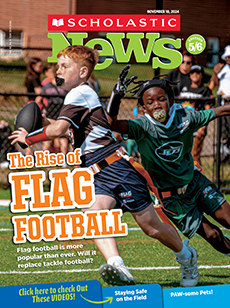Last year, a pair of shocking videos had students at Williams Middle School talking. One showed a group of students fighting at the school in Rockwall, Texas. In the other, a school security officer was arresting one of the kids. Before long, more than 450 people were following the account that posted the video. Many of them had no idea that both videos were fake.
Seventh-grader Kit Atteberry and three classmates had made the videos as part of a class project. They wanted to find out just how easily outrageous videos can spread on social media. They staged a fake fight and asked the security officer to be a part of the hoax. Then they set up a fake account to share the videos. Kit was surprised that so many people believed what they saw.
“I thought everybody would know it was fake right away,”
Countless videos on social media aren’t what they appear to be. Many, like those Kit and his classmates created, are harmless. But other fake videos are meant to affect the way people think about important issues. Last year, an organization called NewsGuard reviewed more than 500 TikTok search results for big topics in the news, such as the war in Ukraine and Covid-19. The study found that about 1 in every 5 videos TikTok suggested contained misinformation—false information that is often meant to trick people.
Last year, a pair of shocking videos had students at Williams Middle School talking. The school is in Rockwall, Texas. One video showed a group of students fighting. In the other, a school security officer was arresting one of the kids. Before long, more than 450 people were following the account that posted the videos. Many of them had no idea that both videos were fake.
Seventh-grader Kit Atteberry and three classmates had made the videos. The videos were part of a class project. The four students wanted to find out just how easily outrageous videos can spread on social media. They staged a fake fight. They also asked the security officer to be a part of the hoax. Then they set up a fake account to share the videos. Kit was surprised that so many people believed what they saw.
“I thought everybody would know it was fake right away,” he explains.
Countless videos on social media aren’t what they appear to be. Many fake videos are harmless, like those Kit and his classmates created. But others are meant to affect the way people think about important issues. Last year, an organization called NewsGuard reviewed more than 500 TikTok search results for big topics in the news. The topics included the war in Ukraine and Covid-19. The study found that about 1 in every 5 videos TikTok had suggested contained misinformation. That’s false information that is often meant to trick people.

